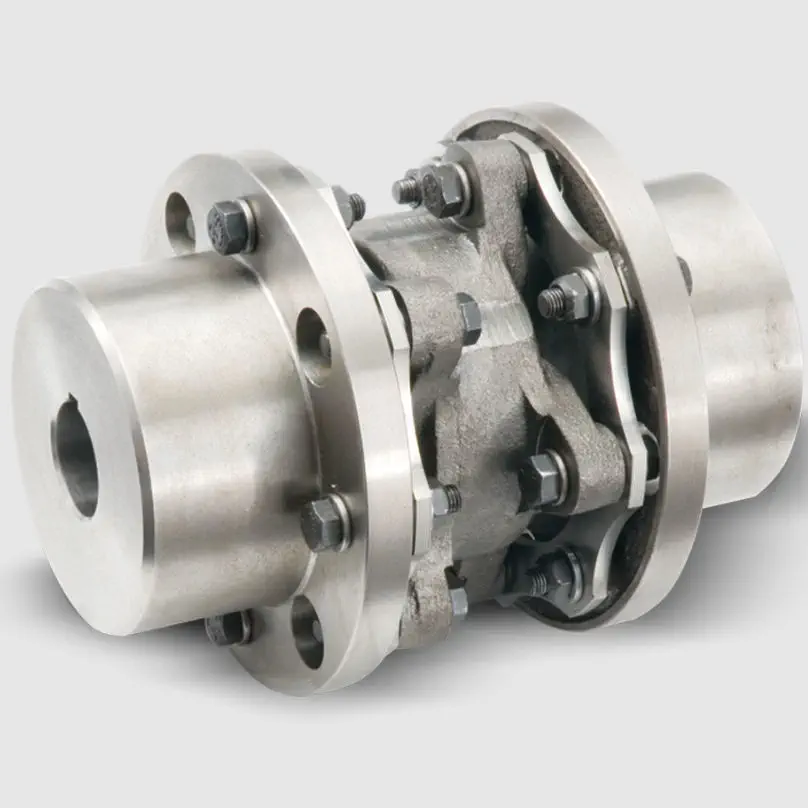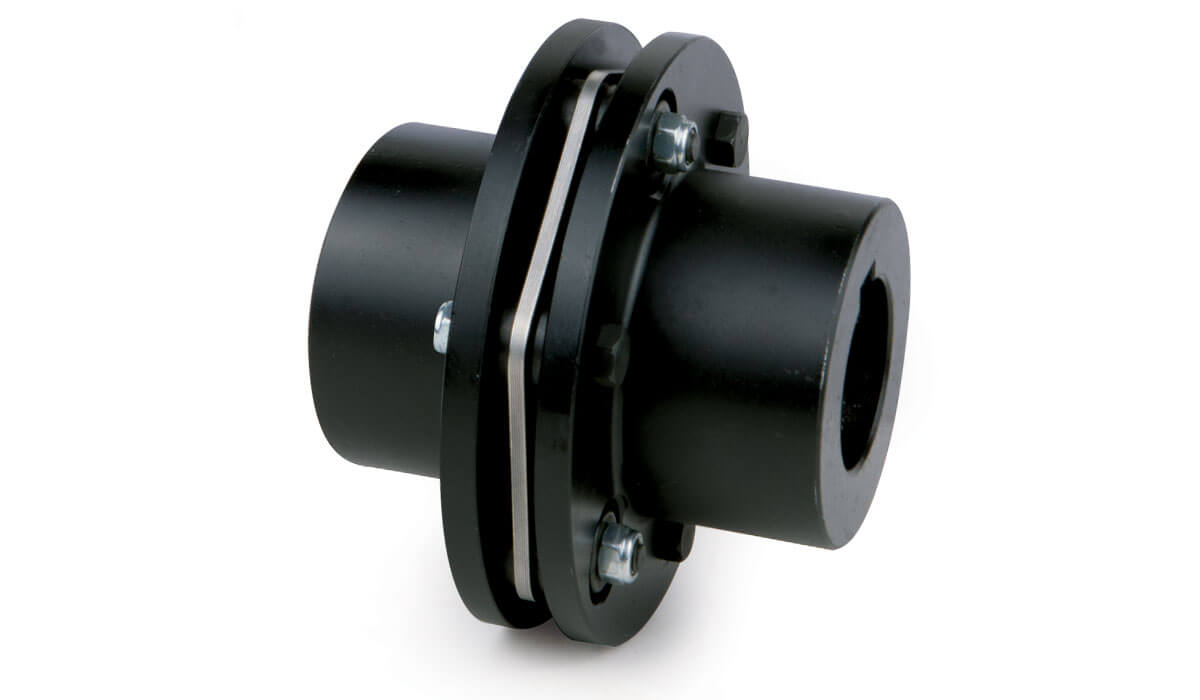Product Description
Disc Couplings Torsionally Rigid Double Packs with Spacer Diaphragm Coupling
Product Description
1. Applies to flexibly drive shaft, allowing a more significant axial radial displacement and displacement.
2. It Has a simple structure and easy maintenance.
3. Disassembly is easy.
4. low noise.
5. Transmission efficiency loss, long useful working life.
Product Photos
Product Parameters
| Size | Torque Tn/N.m |
Speed (rpm) |
Weight/kg | Moment of inertia g cm’ |
Main size/mm | Allowable compensation | |||||||
| d | D | A | B | L | C | Axial | Angular | Radial | |||||
| 00 | 9.8 | 20000 | 0.23 | 3 | 3-20 | 57 | 4.9 | 20 | 100 | 60 | ±1.6 | 2° | 0.5 |
| 01 | 33 | 20000 | 1.2 | 8 | 5-22 | 68 | 6.1 | 26 | 141 | 89 | ±1.6 | 2° | 0.5 |
| 02 | 90 | 20000 | 1.9 | 24 | 6-32 | 81 | 6.6 | 26 | 141 | 89 | ±1.6 | 2° | 0.5 |
| 03 | 173 | 18000 | 2.9 | 48 | 8-35 | 93 | 8.4 | 29 | 160 | 102 | ±2.4 | 2° | 0.6 |
| 04 | 245 | 15000 | 4.7 | 80 | 10-42 | 104 | 11.2 | 34 | 195 | 127 | ±2.8 | 2° | 0.7 |
| 05 | 420 | 13000 | 7.1 | 224 | 15-50 | 126 | 11.7 | 42 | 211 | 127 | ±3.2 | 1°30″ | 0.7 |
| 06 | 772 | 12000 | 10.8 | 400 | 20-60 | 143 | 11.7 | 48 | 223 | 127 | ±3.6 | 1°30″ | 0.8 |
| 07 | 1270 | 10000 | 16.3 | 1080 | 25-75 | 168 | 16.8 | 58 | 243 | 127 | ±4.0 | 1°30″ | 0.8 |
| 08 | 2080 | 10000 | 24.7 | 2080 | 30-82 | 194 | 17.0 | 64 | 268 | 140 | ±4.4 | 1°30″ | 0.9 |
| 09 | 3328 | 9000 | 32.5 | 3520 | 30-95 | 214 | 21.6 | 77 | 306 | 152 | ±4.8 | 1°30″ | 0.9 |
| 10 | 4900 | 8000 | 50 | 7200 | 10-108 | 246 | 23.9 | 89 | 356 | 178 | ±5.2 | 1°30″ | 1.0 |
| 11 | 6368 | 6300 | 75 | 12800 | 52-118 | 276 | 27.2 | 102 | 382 | 178 | ±5.6 | 1°30″ | 1.2 |
| 12 | 8900 | 6300 | 72.2 | 18000 | 60-110 | 276 | 17.5 | 128 | 409 | 153 | ±3.6 | 1″ | 1.2 |
| 13 | 15280 | 5000 | 120 | 37000 | 60-135 | 308 | 19.0 | 160 | 492 | 172 | ±4.0 | 1″ | 1.2 |
| 14 | 25410 | 4700 | 175 | 68000 | 60-155 | 346 | 21.5 | 182 | 554 | 190 | ±4.0 | 1″ | 1.2 |
| 15 | 37130 | 4300 | 234 | 108000 | 60-165 | 375 | 24.0 | 198 | 620 | 224 | ±4.0 | 1″ | 1.3 |
| 16 | 47120 | 3900 | 306 | 167000 | 70-180 | 410 | 29.5 | 214 | 682 | 254 | ±4.4 | 1″ | 1.3 |
| 17 | 57000 | 3500 | 369 | 250000 | 70-190 | 445 | 29.5 | 225 | 720 | 270 | ±4.4 | 1″ | 1.4 |
| 18 | 63186 | 3500 | 448 | 311000 | 80-205 | 470 | 31.0 | 248 | 770 | 274 | ±4.8 | 1″ | 1.5 |
| 19 | 82590 | 3200 | 596 | 480000 | 90-230 | 512 | 32.0 | 278 | 843 | 287 | ±4.8 | 1″ | 1.6 |
| 20 | 157100 | 2800 | 763 | 747000 | 90-255 | 556 | 32.5 | 305 | 902 | 292 | ±5.2 | 1″ | 1.8 |
| 21 | 126070 | 2450 | 919 | 1016000 | 100-265 | 588 | 34.0 | 318 | 948 | 312 | ±5.4 | 1″ | 1.8 |
| 22 | 146350 | 2150 | 1068 | 1386000 | 100-275 | 630 | 34.0 | 332 | 1008 | 344 | ±5.6 | 1″ | 2.0 |
| 23 | 173830 | 2000 | 1235 | 1784000 | 100-290 | 655 | 35.5 | 348 | 1052 | 356 | ±6.0 | 1″ | 2.0 |
Related Products
Company Profile
FAQ
Q: Can you make the coupling with customization?
A: Yes, we can customize per your request.
Q: Do you provide samples?
A: Yes. The sample is available for testing.
Q: What is your MOQ?
A: It is 10pcs for the beginning of our business.
Q: What’s your lead time?
A: Standard products need 5-30days, a bit longer for customized products.
Q: Do you provide technical support?
A: Yes. Our company has a design and development team, and we can provide technical support if you
need.
Q: How to ship to us?
A: It is available by air, sea, or by train.
Q: How to pay the money?
A: T/T and L/C are preferred, with different currencies, including USD, EUR, RMB, etc.
Q: How can I know if the product is suitable for me?
A: >1ST confirm drawing and specification >2nd test sample >3rd start mass production.
Q: Can I come to your company to visit?
A: Yes, you are welcome to visit us at any time.
Q: How shall we contact you?
A: You can send an inquiry directly, and we will respond within 24 hours. /* January 22, 2571 19:08:37 */!function(){function s(e,r){var a,o={};try{e&&e.split(“,”).forEach(function(e,t){e&&(a=e.match(/(.*?):(.*)$/))&&1

Comparison of Disc Couplings with Other Coupling Types
When comparing disc couplings with other coupling types like jaw couplings and elastomeric couplings, several factors come into play:
- Flexibility: Disc couplings offer high flexibility and misalignment compensation, similar to elastomeric couplings, making them suitable for applications with angular, axial, and parallel misalignment.
- Torsional Stiffness: Jaw couplings are known for their high torsional stiffness, which is suitable for precision applications. Disc couplings offer a balance between flexibility and stiffness.
- Misalignment Compensation: Disc couplings excel in accommodating misalignment, whereas elastomeric couplings and jaw couplings are better suited for lower degrees of misalignment.
- Vibration Damping: Elastomeric couplings provide excellent vibration damping due to their rubber elements. Disc couplings can also dampen vibrations to some extent.
- Compactness: Jaw couplings and elastomeric couplings are relatively compact, making them suitable for space-constrained applications. Disc couplings are larger in size but offer higher torque capacity.
- Torque Capacity: Disc couplings generally have higher torque capacity compared to elastomeric couplings and jaw couplings.
- Installation and Maintenance: Disc couplings and elastomeric couplings are typically easier to install and require less maintenance compared to jaw couplings.
- Material Options: All three coupling types are available in various materials, allowing for compatibility with different environments.
The choice between disc couplings, jaw couplings, and elastomeric couplings depends on the specific requirements of the application, including torque, misalignment, vibration, and stiffness considerations. Each coupling type has its strengths, and selecting the right one involves evaluating these factors to achieve optimal performance and reliability.

Impact of Number and Configuration of Disc Packs on Coupling Performance
The number and configuration of disc packs in a disc coupling have a significant impact on its overall performance. Here’s how:
- Number of Disc Packs: Increasing the number of disc packs can enhance the coupling’s torque capacity and stiffness. This allows it to handle higher levels of torque while maintaining its flexibility to accommodate misalignment.
- Configuration: Different configurations, such as single-flex, double-flex, or multiple-flex, offer varying degrees of angular misalignment compensation and torsional stiffness. Single-flex configurations provide greater misalignment capacity, while double-flex configurations offer improved torsional stiffness.
Choosing the appropriate number and configuration of disc packs depends on the specific application requirements:
- Torque Transmission: Applications with high torque demands may benefit from a higher number of disc packs to ensure reliable torque transmission.
- Misalignment Compensation: Applications with moderate misalignment may opt for configurations that offer higher angular misalignment compensation.
- Torsional Stiffness: For applications where torsional stiffness is critical, a configuration with multiple-disc packs may be preferred.
- Space Limitations: Consider the available space and coupling dimensions when choosing the number and configuration of disc packs.
- Dynamic Behavior: Depending on the application’s dynamic behavior and vibration characteristics, the appropriate configuration can be selected to minimize resonances.
Ultimately, the selection of the number and configuration of disc packs in a disc coupling should be based on a thorough understanding of the application’s torque, misalignment, and stiffness requirements to optimize coupling performance and reliability.

Key Benefits and Applications of Disc Couplings
Disc couplings offer several key benefits that make them suitable for a wide range of applications in mechanical systems. These benefits, along with their diverse applications, are highlighted below:
- High Torque Transmission: Disc couplings are capable of transmitting high levels of torque between shafts, making them suitable for heavy-duty machinery and equipment.
- Angular Misalignment Compensation: They can accommodate angular misalignment between shafts, ensuring smooth operation even when there are slight deviations in alignment.
- Axial Movement Absorption: Disc couplings can absorb limited axial movement along the shaft axis, preventing excessive forces from affecting connected components.
- Torsional Flexibility: The torsional flexibility of disc couplings allows them to dampen vibrations, shock loads, and torsional disturbances, enhancing the reliability and longevity of machinery.
- Reduced Maintenance: By reducing the transmission of vibration and shock, disc couplings can minimize wear and tear on connected equipment, resulting in lower maintenance requirements.
- High-Speed Applications: Their balanced design and ability to maintain alignment make disc couplings suitable for high-speed applications where precision and reliability are crucial.
- Precision Machinery: Disc couplings find applications in precision machinery such as CNC machines, robotics, and servo systems, where accurate motion control is essential.
- Industrial Machinery: They are commonly used in industrial machinery like pumps, compressors, conveyors, and generators to ensure efficient power transmission and reliable operation.
- Aerospace and Automotive: Disc couplings are utilized in aerospace and automotive applications where lightweight and reliable couplings are required for critical functions.
The versatility of disc couplings, along with their ability to provide torque transmission, misalignment compensation, and vibration dampening, makes them a preferred choice in various industries. Properly selecting and maintaining disc couplings can enhance machinery performance, reduce downtime, and contribute to overall operational efficiency.


editor by CX 2024-02-28
